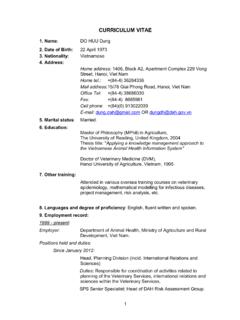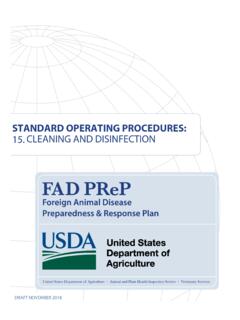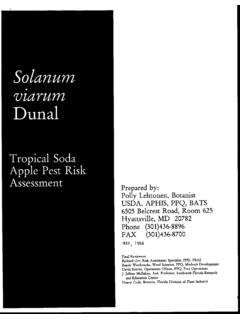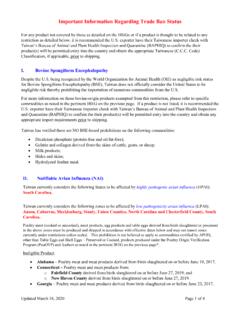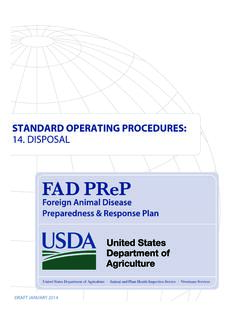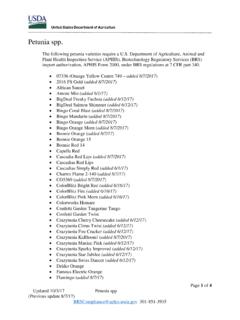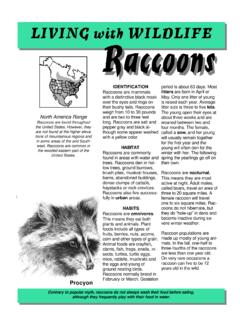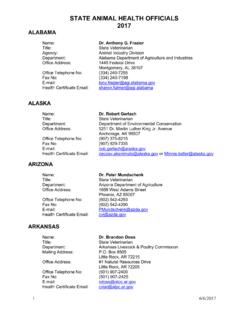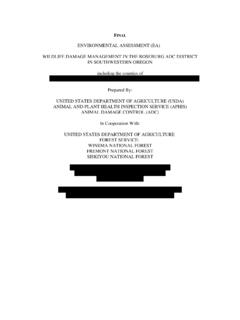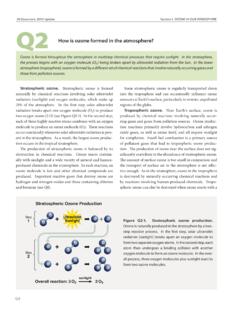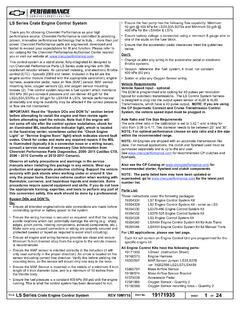Transcription of Overview of Aquaculture in the United States
1 Overview ofAquaculture in theUnited StatesCenters for Epidemiology & Animal HealthUSDA:APHIS:VS2150 Centre Ave., Bldg. B, MS 2E7 Fort Collins, Colroado 80526-8117(970) 1995 Aquaculture in the United States is a diverse industry which includes production of a variety offish, crustaceans, molluscs, and plants. Total estimated Aquaculture production in 1992 was313,518 metric tons with production income totaling $724 million (1). Thus, in terms ofeconomic importance, the Aquaculture industry is comparable in value to the sheep industry andequivalent to either 18 percent of the swine industry or 30 percent of the turkey industry. Also, aninfrastructure of producers, processors, wholesalers, and retailers exists that is similar to thatfound in traditional livestock. A system of providers exists, which numbered over 2,000 in 1994,that supplies feeds, vaccines, fish diagnostics, medications, growth hormones, and physicalequipment (pumps, feeders, processing machines) (2).
2 The objective of this report is toinvestigate diversity within the industry by providing an Overview of the types of aquatic animalsbeing cultured in the , trends in the size and geographic distribution of specific components ofthe industry, existing Federal and State regulations, and Veterinary Services current role Aquaculture SpeciesThere are five principal Aquaculture fish species in the (catfish, trout, salmon, tilapia, andhybrid striped bass) and two categories of non-food fish production (baitfish and ornamental fish). Contribution to total Aquaculture production of other fish species such as walleye, sunfish, andlargemouth bass is rather limited. In addition to fish, several crustacean species, crawfish andvarieties of shrimp, and molluscs are commercially important. Although each of these Aquaculture industries is developing independently, one limit to theircombined expansion in the domestic market will be consumer demand for Aquaculture products.
3 Demand will be primarily in the form of consumption, except for the baitfish and tropical fishindustries. Per capita consumption of fish (canned, fresh and frozen, cured) in the increasedfrom to pounds per capita in the early 1980's but subsequently has remained relativelystable (Figure 1) (1). The average per capita consumption of fish is less than consumption of beef( pounds), poultry ( pounds), or pork ( pounds), but substantially more than veal ( ) or lamb ( pounds) (3). Since consumption of Aquaculture products does not appear to be increasing substantially in , industry development will depend on becoming competitive on the international market andfilling the niche left by declining catches from the ocean. In 1992, the National Marine FisheriesService (NMFS) listed fisheries stocks, many of which are the Nation's most valuable fisheriesresources, that are being over utilized and/or are below the population levels need to sustainprojected yields (4).
4 The fisheries include New England groundfish, Atlantic sea scallops, gulfshrimp, highly migratory pelagic stocks, Pacific salmon stocks, and many near shore stocks (someoyster populations, bay scallops, abalones, Pacific striped bass). CatfishCatfish, primarily the channel catfish (Ictalurus punctatus), is by far the largest aquacultureindustry in terms of weight of product (Table 1) and value (Table 2)(1). Between 1983 and1992, the value of the catfish industry represented almost 40 percent of the total estimatedvalue of the Aquaculture industry. A majority of the catfish industry is located in the southwhere longer growing seasons and warmer water is conducive to production (Figure 2).USDA:APHIS:VS2 Total water surface area in production in 1994 was 153,640 surface acres with 97 percent ofthe acreage occurring in five States : Mississippi (93,700 acres), Arkansas (21,900 acres),Alabama (18,170 acres), Louisiana (11,070 acres), and Georgia (4,000 acres) (5).
5 All otherStates each had less than 2,500 surface acres in 1994. The geographic distribution of theindustry has been fairly stable since the early 1980's (Figure 2)(6). Since 1982, the industryhas increased in number of farms from 1,494 to 2,155 with most of the increase occurringbetween 1982 and 1987 (Table 3). Much of the increase in the number of farms has occurredin three States (Louisiana, Mississippi, and Alabama), while notable increases have occurredin both of the Carolinas. Growth of the catfish industry was fairly steady throughout the 1980's, but in the last few yearsproduction has been a leveling off. In 1994, catfish production fell 4 percent as farmers cut backdue to low prices in 1993 (7). However, production is expected to expand 5-7 percent in 1995due to increasing sales prices. Total acreage of ponds for catfish culture was up in 1994 by 1percent which follows 2 years of decline. Overview of Aquaculture in the United States Miscellaneous includes ornamental fish, alligators, algae, aquatic plants, hybrid striped1bass, tilapia,and 1 - Estimated Aquaculture production (metric tons) of selected species.
6 (Source: NMFS:Fish. Stat. Div.)SpeciesYear198319841985198619871988 1989199019911992 Baitfish10,00010,70411,25211,70611,79411 ,97510,8999,8029,6089,352 Catfish62,25669,97086,91696,959127,23213 3,861155,085163,492177,297207,460 Salmon8331,2131,7791,3051,8253,0743,8574 ,1147,59910,858 Trout21,95422,65322,95223,13325,51325,41 625,18725,77226,95425,521 Clams7629479071,1631,0939651,0751,6691,7 161,942 Crawfish31,52430,06429,48931,67631,75229 ,86829,93732,20527,48128,591 Mussels33535554953352848328027595128 Oysters8,80711,5059,93611,10210,85311,06 710,09510,0669,35910,880 Shrimp1251441218191130159184184147(Fresh water)Shrimp1162392006141,2059986809001, 6002,000(Saltwater)Misc. 3,1754,4916,3507,0317,7349,07211,34011,2 1812,12716,6381 Total139,887152,285170,451185,304219,619 226,909248,584259,697274,021313,518 WeightThe long-term trend appears to be similar to what has occurred in other animal industries: concentration into fewer but larger farms. Still there appears to be room for smaller producers,since the average size of fish farms in Mississippi dropped by 20 acres to 323 acres in 1994 (7).
7 More detailed analysis of production and processing linkages would be necessaryto determine the future role of small producers. The industry is trying to promote itself asevidenced by a 1994 Catfish Institute investment of $ million on an advertising campaign thatwas designed to increase public awareness of farm-raised catfish (2).TroutTrout, principally rainbow trout (Oncorhynchus mykiss), production is about one-sixth the size ofthe catfish industry on weight basis but about one-fourth the size on a value basis (Tables 1 and 2). Between 1983 and 1992, value of the trout industry represented 13 percent of the total estimatedvalue of the Aquaculture industry. The number of trout farms was 513 in 1982 and 577 in 1992 (6). Trout farms are spread throughout the country, except they do not tend to be found in the southeast(Figure 3). Need for cooler water temperatures during the whole year is the principal driving forcein determining the industry's geographic distribution.
8 The geographic distribution of trout farmsover time indicates an increase in numbers of farms in the eastern , especially North Carolina. USDA:APHIS:VS Miscellaneous includes ornamental fish, alligators, algae, aquatic plants, hybrid striped2bass, tilapia, and 2 - Estimated value of Aquaculture production of selected species (X $1,000). (Source: NMFS: Fish. Stat. Div.)SpeciesYear198319841985198619871988 1989199019911992 Baitfish44,00047,04551,28051,52271,50071 ,00062,48953,97855,94861,183 Catfish83,860106,899138,922142,789173,34 7225,463245,142273,210246,639273,506 Salmon2,5483,4145,4654,3997,46220,64723, 74226,34144,15675,193 Trout50,00054,43555,15455,59057,55657,92 760,04164,64059,14253,942 Clams6,3686,6704,6988,17310,31111,32012, 72113,48611,13311,539 Crawfish32,66427,93629,35035,00929,40024 ,36420,46034,00033,28524,860 Mussels3403096421,0321,0241,1301,1361,17 39471,162 Oysters32,03447,90638,88249,66649,54958, 90058,08277,94963,46382,432 Shrimp1,5001,6981,5418931,2501,9222,5372 ,4072,4071,728(FW)Shrimp5108741,5661,687 3,4087,6097,5517,93714,11017,637(SW) ,0009,90020,00021,70032,28540,00045,6009 9,991104,998111,0052 Total260,824307,086347,500372460437,0925 20,282539,501655,112636,228724,187 Value Value of production provides a different perspective on the industry.
9 Idaho produces 50 percent farmed trout with the next closest State being North Carolina, which accounts for percentof the trout production (Table 4)(6). Total production is increasing at a higher rate thanis the rate of increase in Idaho which has resulted in declining percentage of total production forIdaho in spite of steadily increasing actual production. Production of trout was fairly steady during the mid-1980's and into the early 1990's (Table 1).Sales of live trout and trout products peaked in 1990 at $ million (Table 2). Decliningproduction, somewhat offset by recent increases in sales prices, resulted in sales of only $ in 1994 (7). Sales in all facets of the industry except exports (eggs, fingerlings, stocker,and food-size fish) declined in 1994 (7). Exports of trout products have steadily increased in therecent past, but still only represent about 5 percent of estimated production, and are roughlyequivalent to trout imports.
10 These trends combined seem to indicate that the trout industry is notpoised for substantial expansion in the near future. A major constraint may be the availability ofsufficient supplies of cool, clean water that can be diverted to Aquaculture production. Forexample, flow-through production Overview of Aquaculture in the United States5 USDA:APHIS:VS6 Table 3. - Number of farms for selected freshwater species in 1982, 1987, and 1992. (Source: Dept. of Comm., 1992 Ag. Census)YearSpeciesCatfishTroutHybridCraw fishOtherOther AquacultureStripedFishProductsBass19821, 494 513 NA NA NA 128 19872,071 547 NA NA NA 443 19922,155 577 121 340 669 397 can require between 5,000 to 10,000 gallons of water to produce a pound of fish (8). The UnitedStates Trout Farmer's Association is trying to implement a quality assurance program thatemphasizes decreasing production costs, improved management practices, and avoidance of drugand chemical residues (2).
